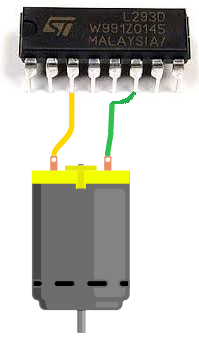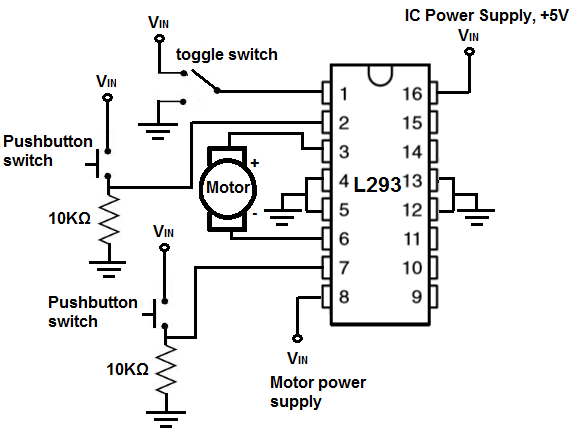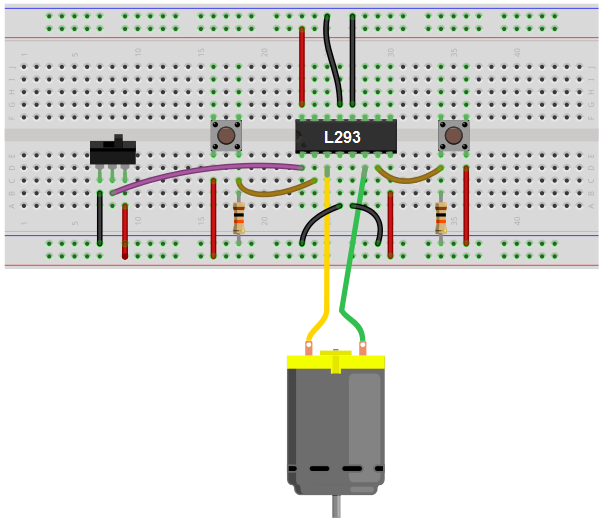How to Build an H-bridge Circuit

An h-bridge is a chip that allows DC motors to be run versatile as they are meant to- with an H-bridge, we can make a DC motor go forward, go reverse, and stop.
This directional ability that H-bridges allow in DC motors can equate to forward-reverse movement, right-left movement, or up/down movement, depending on the use of the motor in the circuit.
Without an H bridge, we could only make use of the bidirectional capabilities of an H-bridge with either extensive software programming or having to manually switch the voltage polarity to the DC motor to make it change directions; this means we would have to physically swap out the voltage polarity to get the motor to change directions.
Obviously, an H-bridge IC makes this a lot simpler.
In this circuit, we will show how to connect an H-bridge to a DC motor so that we can have the motor exhibit bidirectional capability.
This is really what makes an H-bridge. It can make a DC motor go forward and then in reverse.
We'll go over now how we can easily connect this up.
Components
- L293/SN754410 H-bridge Chip
- DC Motor
- 2 Pushbutton Switches
- Toggle Switch
- 2 10KΩ resistors
- Power Source
The L293/SN754410 H-bridge chip is 16-pin chip that can be used to drive and control inductive loads such as relays, solenoids, DC motors, and bipolar stepper motors.
However, in this project, we will be using a DC motor with the L293.
The L293/SN754410 is a relatively inexpensive chip that can be obtained for a little over $1. One place that sells the L293 is Tayda Electronics- L293 Driver IC.
Before we build this circuit, you must understand the chip and all of its pin connections. You must always know pin connections when hooking up any chip.
Overall, the L293/SN754410 chips aren't very as complicated as they may seem. They both have identical pinouts.
The pinout of the L293/SN754410 is shown below.

The L293/SN754410 is capable of controlling 2 motors.
It is a 4-channel H-bridge, meaning it can connect 4 terminal wires from motors. Since each motor has 2 terminals, it can control 2 motors (2x2=4).
Pin 1 is the enable pin for terminals 1 and 2. It enables motor to turn on when it is connected to a power. And disables the motor from functioning when connected to ground.
Pin 2 is the motor logic pin for terminal 1. This is the voltage level which one of the motor terminals receive. The logic level will determine what action the motor will take. This is one of the two logic levels that determines the function of the motor connected.
Pin 3 is the pin where we connect one of the terminals of the motor to.
Pin 4 and Pin 5 both get grounded.
Pin 6 is where we connect the other motor terminal to. This completes the 2-terminal connections necessary for a motor to be hooked up to the H-bridge IC.
Pin 7 is the motor logic pin for terminal 2. This is the second voltage signal we feed to the motor to determine the action the motor will take.
Pin 8 is the pin which receives the voltage needed to power on the motor. It is the motor power pin. This is the pin where we place the positive voltage of the power supply that will operate the DC motor. So if the motor is a 9V motor, then you will need to feed 9V into this pin. If the motor is a 12V motor, then you will need to feed 12V into this pin.
Pin 9 is the enable pin for terminals 3 and 4. It enables the motor to turn on when connected to power and disables the motor when connected to ground.
Pin 10 is the motor logic pin for terminal 3. This is one of the logic voltage signals that determines the action that the second motor will take.
Pin 11 is the pin where we connect one of the terminals of the second motor to.
Pin 12 and Pin 13 both get grounded.
Pin 14 is the pin where we connect the other terminal of the second motor to.
Pin 15 is the motor logic pin for terminal 4. It is the second voltage signal that we feed into the second motor to determine the action the motor will take.
Pin 16 is the pin which receives the voltage needed for power for the IC. It is the IC power pin. The IC needs just about 5V in order to operate.
Therefore, we feed 5V into this pin.
These are all the pins of the motor. Once power is supplied to the IC and the motor and all the terminals of the motor are connected, then the pins which determine how the motor will operate are the logic levels that we feed into the motor.
The logic levels determine what action the motor will take.
A breakdown of logic levels and the resultant motor action are shown in the table below.
| Enable | Logic Pin 1 | Logic Pin 2 | Result |
| High | Low | High | Forward |
| High | High | Low | Reverse |
| High | Low | Low | Stop |
| High | High | High | Stop |
| Low | Doesn't matter | Doesn't matter | Off |
When the enable pin is high and the motor is fed a LOW voltage signal at the first terminal and a HIGH voltage signal at the second terminal, then it will spin forward. When the enable is high and the motor is fed a HIGH voltage signal at the first terminal and a LOW voltage signal at the second terminal, then it will spin in reverse. And with both logic levels at the same level (2 HIGHs or 2 LOWs), then the motor will stop spinning.
And this is how motor function will work.
H-bridge Circuit
The H bridge circuit we will build is shown below.

This above circuit built on a breadboard is shown below.

How this circuit works is based on the 3 switches.
First, turn the toggle switch to the ON position. This enables the motor to function. With this switch disabled, the motor will not do anything.
Now, there are 2 pushbuttons. The 2 pushbuttons are connected to the H-bridge IC using pull-down resistors. Without pressing down on them, they are normally LOW (connected to ground). Thus, when both pushbuttons aren't pressed, they're both at LOW logic levels. The motor does not move.
Now if we press down on the first pushbutton, which is connected to motor terminal 1, then the motor will spin in a forward direction. Once we release the pushbutton, then the motor will shut off.
Now if we press down on the second pushbutton, which is connected to motor terminal 2, then the motor will spin in a reverse direction. If we release from the press, the motor will shut off.
Now if we press down on both pushbuttons simultaneously, then both will be at HIGH logic levels, and the motor will not spin.
And this is how an H-bridge circuit can allow for forward and reverse movement of a motor.
This circuit shows how an H-bridge would work if control by manual pressing is wanted.
To see the real-life circuit of it below, see the video below.
Related Resources
How to Build an H-bridge Circuit to Control 2 Motors
How to Build an H-bridge Circuit to Control 4 Motors
How to Build an H-bridge Circuit with an Arduino Microcontroller
How to Build an H-bridge Circuit with Transistors
